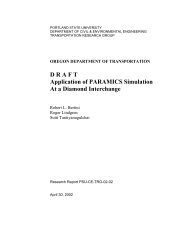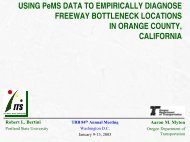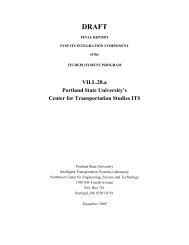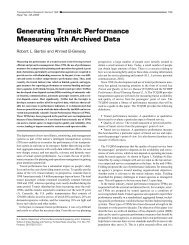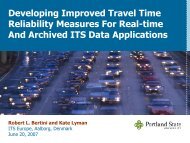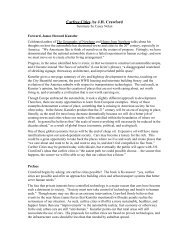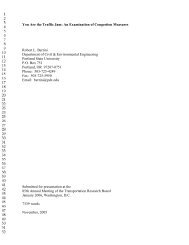Application of Paramics Simulation to a Diamond Interchange
Application of Paramics Simulation to a Diamond Interchange
Application of Paramics Simulation to a Diamond Interchange
You also want an ePaper? Increase the reach of your titles
YUMPU automatically turns print PDFs into web optimized ePapers that Google loves.
<strong>Application</strong> <strong>of</strong> PARAMICS <strong>Simulation</strong> at a <strong>Diamond</strong> <strong>Interchange</strong> Page 10<br />
Data Collection<br />
Afternoon peak hour intersection turning movement counts for a number <strong>of</strong> the intersections<br />
in the study area intersections were acquired by DKS Associates, an engineering consulting<br />
firm, in April 1999. Figure 3 show the DKS turning movement counts. Aerial pho<strong>to</strong>graphs<br />
obtained from GlobeXplorer Inc. and as-built construction CAD drawings provided by the<br />
City <strong>of</strong> Wilsonville were used <strong>to</strong> establish network geometry. Ground level pho<strong>to</strong>graphs<br />
were taken <strong>of</strong> the approaches <strong>of</strong> each intersection <strong>to</strong> provide network detail that was not<br />
apparent from the aerial pho<strong>to</strong>graphs.<br />
The four signalized intersections in the study area are controlled by fully actuated signals.<br />
However, during the congested afternoon peak period, the signals appeared <strong>to</strong> operate with<br />
phase timings that approached fixed-time condition (as is <strong>of</strong>ten the case at diamond<br />
interchanges). Fixed-timed signal phase lengths for the computer model were based on the<br />
average <strong>of</strong> ten observed p.m. peak period cycles obtained on December 13, 2001.<br />
SOFTWARE INSTALLATION<br />
For PARAMICS operation on a PC, Quads<strong>to</strong>ne recommends a computer with a Pentium 266<br />
or better processor, 64MB Memory, and 100MB hard disk space. A graphics card supporting<br />
OpenGL, minimum 1280x1024 resolution, and 32Bit color depth is suggested. The<br />
PARAMICS s<strong>of</strong>tware is designed for UNIX operating systems. In order <strong>to</strong> execute<br />
PARAMICS under a Windows operating system on a PC, a separate piece <strong>of</strong> emula<strong>to</strong>r<br />
s<strong>of</strong>tware known generically as “X-windows s<strong>of</strong>tware” is required. PARAMICS recommends<br />
the use <strong>of</strong> Exceed and Exceed 3D X-windows s<strong>of</strong>tware produced by Hummingbird Ltd. <strong>of</strong><br />
North York, Ontario, Canada. Exceed s<strong>of</strong>tware was used in the research detailed in this<br />
report. The X-Windows s<strong>of</strong>tware must be installed on the computer before PARAMICS is<br />
installed. (14)<br />
In order <strong>to</strong> operate PARAMICS with full functionality, a current s<strong>of</strong>tware license file issued<br />
by Quads<strong>to</strong>ne and a hasp key (connected <strong>to</strong> the computer’s parallel port) are required.<br />
PARAMICS Modeller can however, be executed without license or hasp key in a Viewer<br />
Mode as described in Figure 4. The Viewer Mode allows models <strong>to</strong> be viewed but not<br />
modified.<br />
MODEL IMPLEMENTATION<br />
The typical implementation steps involved in a microscopic traffic simulation model are as<br />
follows:<br />
• Road network coding<br />
• Traffic demand matrix input<br />
• Traffic assignment technique selection<br />
• <strong>Simulation</strong> run execution (normally with visualization)<br />
• Base model calibration (by comparing model results <strong>to</strong> observed data)<br />
• Model validation the model against independent data<br />
Portland State University Transportation Research Group 2002



